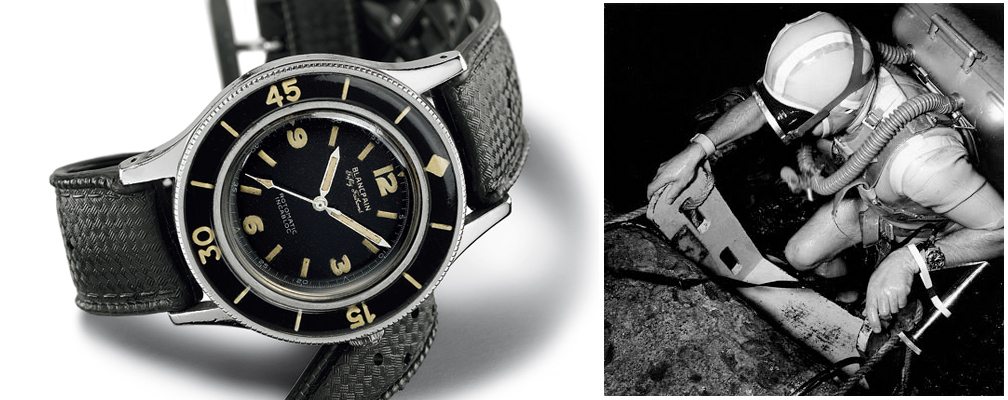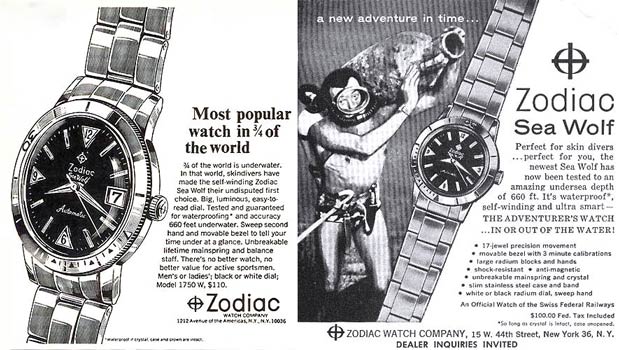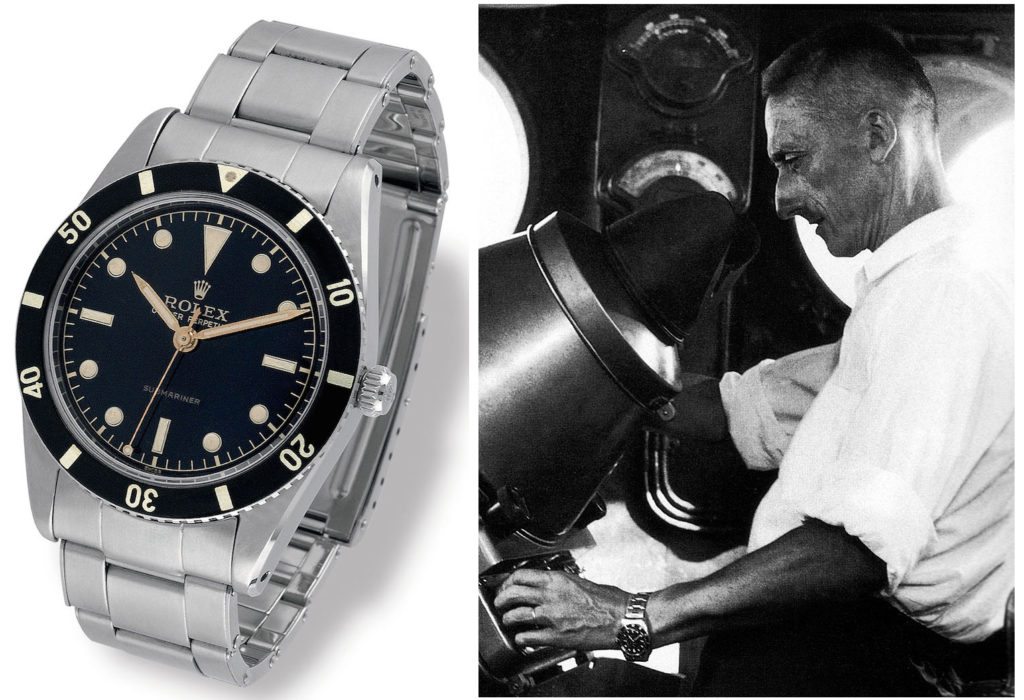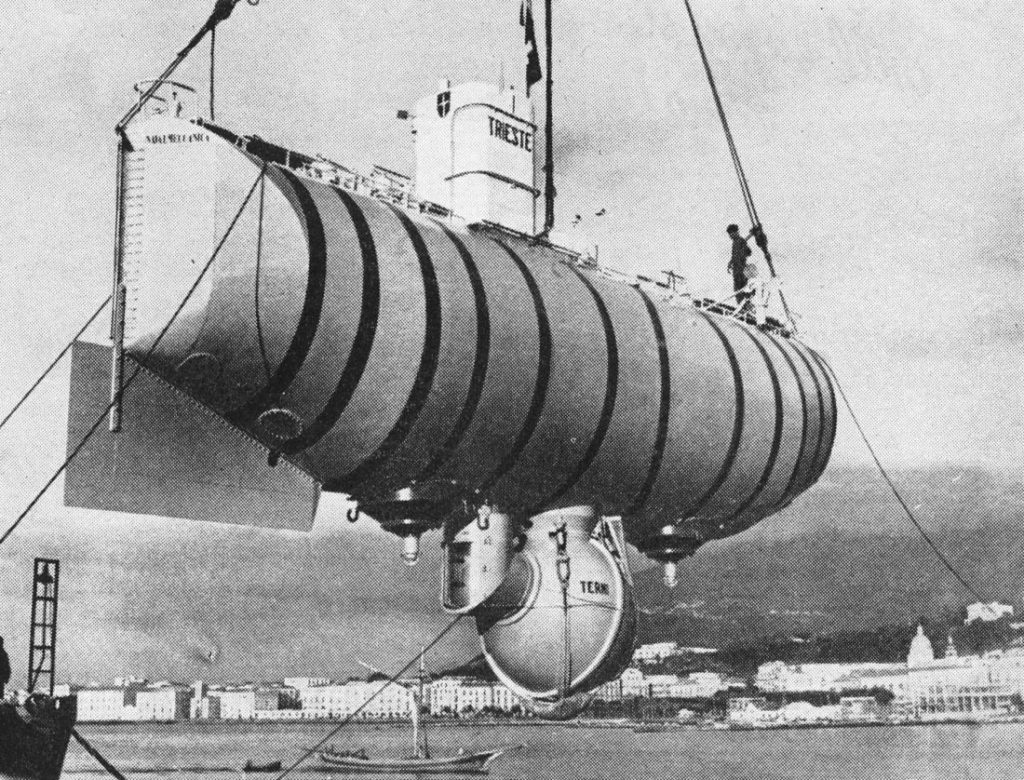We previously covered the origins of the dive watch in Part One, but, despite its beginnings, when exactly did the dive watch truly enter into the public consciousness, not only as a tool watch for divers, but as a lasting fashion accessory? The post-war period of the 1950’s was ripe for diving as a sport, thanks to Jacque Cousteau’s invention of the aqualung and his popularization of sea exploration, and 1953 in particular saw the introduction of quite a few dive watches to the consumer market that are now considered iconic.
The Blancpain Fifty Fathoms
Blancpain’s Fifty Fathoms was originally intended to fulfill a military need, much like the Panerai Radiomir. Captain Robert “Bob” Maloubier and Lieutenant Claude Riffaud, who ran the French Navy’s Combat Diving School in the years after World War II, approached Blancpain to help them develop a durable diving tool for the military’s combat swimmers. Luckily for them, Jean-Jacques Fiechter, Blancpain’s CEO from 1950 to 1980, was an avid diver, and in him they found a kindred spirit up for the challenge.
The watch was designed to be waterproof up to a depth of 50 fathoms, or almost 100 meters, and it was the first to feature a rotating bezel that helped gauge oxygen usage underwater. In order to minimize the wear that came with a manual winding crown, Blancpain also designed the watch with an automatic movement resistant to magnetic fields.

The Blancpain Fifty Fathoms, and Bob Maloubier wearing his.
When the Fifty Fathoms was finally introduced to the market in 1953, it was sold in diving shops rather than in jewelry stores – the mark of a true diving tool. It only gained popularity and prestige once Jacques Cousteau wore it during the historic dives chronicled in his award-winning film “Silent World.”
The Zodiac Sea Wolf
In contrast to the Fifty Fathoms’ rising pedigree over the years, the Zodiac Sea Wolf has mostly fallen by the wayside, due in part to the Quartz Crisis of the 60’s and 70’s, and in part to its unfortunate association with the infamous Zodiac killer. But when it was first introduced in 1953, it was the ultimate tool watch and quickly gained popularity with soldiers on the ground in Southeast Asia.

At the time, the Sea Wolf stood out not only because of its affordable price point, but because it was quite unlike anything on the market. For one, it was only 35mm, which made it smaller than the bulky, big-dial dive watches used for military purposes. But what made the Sea Wolf so notable was its ability to go to depths of 200 meters, which made it the most durable of any dive watch at the time.
The Rolex Submariner
While it technically wasn’t introduced until 1954, the Rolex Submariner deserves its place in dive watch history.
The Submariner’s now-classic design was purposeful – René-Paul Jeanneret, a member of the Rolex board of directors, suggested that the company create a watch that could function for divers, but which also incorporated a more elegant, everyday look. Hans Wilsdorf delivered, producing a tool watch with a rotating bezel, luminous markers, and a less-sporty design that could transition into any situation. This precise detail of the Submariner’s design is what makes it one of the most ubiquitous watches in the world today.

The Rolex Submariner ref. 6204. | Jacques Coustea wearing his Sub.
But more relevant to divers of the time, the Submariner needed credentials. And what better way to advertise the Submariner’s release than to really put it to the test in true Rolex fashion?

Auguste Piccard’s Trieste Bathyscaphe.
That’s when the company recruited Auguste Piccard, the Swiss physicist and explorer. In 1953, Piccard, in his Bathyscaphe deep-diving submarine, went down over 3100 meters in the ocean, and a specially-created Rolex Submariner descended with him attached to the ship’s hull. When the Bathyscape came out of the water, the Rolex watch was still working properly. It’s also interesting to note that 7 years later in 1960, Auguste’s son Jacques Piccard and Don Walsh of the US Navy, took the Rolex Deep Sea with them as they explored the lowest point on the Earth in the Mariana Trench – but it was the Rolex Submariner that first established the connection between the company and the Piccards’ explorations.
At the height of diving’s popularity as the sport for leisure and at the beginnings of man’s oceanic exploration, the dive watch enjoyed the associations of being the essential diver’s tool. Now, its complications may be somewhat superfluous in a world that values it mainly for its aesthetics. Either way, in the past and in the present, the dive watch retains its relevancy because of its versatility, its classic design, and its extreme usefulness when put under pressure.
Image credits: Featured | 1 | 2 | 3 | 4 | 5 | 6
Get More Articles Like This in Your Inbox
We're constantly creating great content like this. So, why not get it delivered directly to your inbox? By subscribing you agree to our Privacy Policy but you can unsubscribe at any time.






